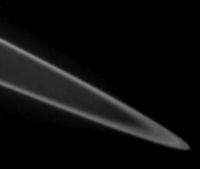
NASA probe discovers lightning at Jupiter's poles
A NASA spacecraft observed lightning strikes at Jupiter's poles as it provided insights into the giant planet's dynamic atmosphere as well as volcanic activity on one of its moons, scientists said on Tuesday.
The New Horizons spacecraft, passing by the solar system's largest planet en route to the dwarf planet Pluto, also snapped images of the tiny rings encircling Jupiter, studied a huge, swirling storm and explored the planet's long magnetic tail.
NASA released full scientific findings from the mission in the journal Science after discussing highlights earlier this year.
New Horizons zipped by Jupiter earlier this year, making its closest pass on February 28, and used the gaseous planet's considerable gravity to slingshot itself toward Pluto. The piano-sized robotic probe is due to reach Pluto in July 2015.
But while in the neighborhood, the fastest spacecraft ever launched from Earth aimed its cameras and sensors at Jupiter and its four largest moons, making about 700 observations.
"This was drive-by science at its best," Jeff Moore of the New Horizons Jupiter Encounter science team at NASA Ames Research Center in California, said in a telephone interview. "The encounter went off as well as it possibly could have."
Io is known for having active volcanoes on its surface. One of the 11 volcanic plumes detected was particularly dramatic.
Rising 200 miles into space from the volcano Tvashtar was an umbrella-shaped plume of dust, captured in what scientists called the best images ever taken of a giant eruption from Io.
HUGE ERUPTION RECORDED
"By incredibly good luck, we just happened to arrive at a time when one of these rare 'super eruptions' took place," Moore said.
New Horizons allowed the scientists to gain a greater understanding of Jupiter's dynamic atmosphere. For example, they saw lightning strikes at the two poles, a phenomenon previously witnessed only on Earth.
Lightning strikes had been documented elsewhere on Jupiter. The new findings showed lightning is not concentrated near the planet's equator, suggesting that convection clouds are spawned by heat differences all over Jupiter, the scientists said.
The probe made the first close-up observations of Jupiter's second-largest storm, dubbed "the Little Red Spot" to differentiate it from the "Great Red Spot," another swirling storm that is twice as big. Nevertheless, the little one is still 70 percent as big as the Earth's diameter.
"Take 'little' with a grain of salt," Alan Stern, the New Horizons lead scientific investigator, told reporters. "This is an extremely large storm on a giant planet."
Jupiter is encircled by tiny rings that are much smaller and less dramatic than those around its neighboring planet Saturn. Scientists said New Horizons sent back the clearest images to date of these rings of Jupiter.
They saw evidence indicating a meteorite had recently smashed into one ring. They also observed how the small inner moons Metis and Adrastea seemed to lead material like dust and boulders around the rings.
New Horizons also tracked charged particles that flow hundreds of millions of miles beyond Jupiter in the planet's long magnetic tail. It found that material from Io's volcanoes moves down this tail in slow-moving blobs.
The probe came within 1.4 million miles of Jupiter. By getting a boost from Jupiter's gravity, it will cut three years off its trip to Pluto, NASA said.

No comments:
Post a Comment